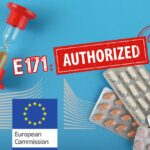
Nanoparticles and neurotoxicity: new insights but still too many grey areas
Three publications have particularly caught our attention this summer. Three publications have particularly caught our attention this summer. They all report on the possible effects of certain nanoparticles on the brain, on the barrier that protects it and on the functioning of certain neurons. Their results, which are relatively worrying, argue for intensifying research efforts on the neurotoxicity of nanoparticles, which has not been sufficiently studied until now.
Some nanos manage to cross the barrier supposed to protect our brain
A post on the European Observatory for Nanomaterials (EUON) website in mid-September relays the results of a study published last summer showing that certain nanometric substances can cross – and even damage – the blood-brain barrier (BBB) which usually protects the brain from pathogens and toxins circulating in the blood. The study was performed on an artificial model mimicking the human BBB. If nanos are considered in nanomedicine as an interesting avenue for developing vectors capable of crossing the BBB and delivering drug substances to the brain in order to treat certain neurological pathologies, it is on the other hand much less desirable that our brain be exposed, the rest of the time, to manufactured nanoparticles present in the air, water or products that surround us (and which would have succeeded in passing into the bloodstream after having crossed other barriers: pulmonary, intestinal or dermal).
However, not all nanoparticles seem to be able to cross this barrier; the size, shape or solubility of the nanosubstances are decisive, even more than their concentration.
According to University of Birmingham researcher Eugenia Valsami-Jones, who co-authored the aforementioned blog post and scientific article, smaller particles and spherical particles are more likely to cross the BBB than larger or fibrous-shaped particles.
Other key information: the silver and zinc oxide nanoparticles studied can cross the BBB, unlike cerium or iron oxide nanoparticles – the latter having a very low solubility in the liquid medium used for the culture of human cells used in this artificial BBB model.
Although only a small portion of the nanoparticles ultimately reach the brain (the rest of the nanoparticles being redirected to the bloodstream), these results raise the crucial question of the short-, medium- and long-term effects of exposure of our nervous system to nanoparticles.
The publication of this study comes ten years after that of the CEA, widely reported at the time, attesting to a possible passage of titanium dioxide nanoparticles through an artificial model of BBB based on rodent cells).
What happened in the meantime? Is this fundamental subject the subject of other research projects today?
AVICENN is interested in any element available on this subject, especially since nanomaterials that can cross the blood-brain barrier are also likely to damage it in passing – at the risk of making it more permeable to other potentially neurotoxic products (this is the so-called “Trojan Horse” effect).
What adverse effects do nanos have on (and via) neurons?
Damage to brain functions have already been reported in animals under the effect of exposure to various nanomaterials, with the effects – direct or indirect – of cognitive problems, memory and learning disorders, degeneration of nerve cells and even neuronal death and brain lesions and a decrease in locomotor capacities1See our fact sheet on the health effects of nanos, paragraph “Effects on the brain and nervous system”).
Last year, Eugenia Valsami-Jones’ work cited above showed that silver and zinc oxide nanoparticles that have crossed the BBB can subsequently harm astrocytes (cells in the central nervous system that control and modulate neuronal activity).
This summer, two studies conducted by French teams and published in the journal Particle and Fibre Toxicology have added to the (still fragmentary) picture of the potential damage of nanos on neuronal activity.
An Alzheimer trigger effect of titanium dioxide and carbon black nanoparticles?
A study published in July by researchers from INSERM, CNRS and ANSES shows for the first time that nanoparticles of titanium dioxide and carbon black, when in contact with mouse neurons in culture, can trigger the expression of molecular signals specific to those expressed in Alzheimer’s disease, a neurodegenerative disease that leads to progressive loss of memory and certain intellectual functions.
As a reminder, these nanoparticles are at the top of the list in the tonnages of nanos declared in the French r-nano register (between 10 and 100,000 tons each year for each of these nano substances).
However, these nanoparticles trigger a cascade of intra-cellular molecular events leading to:
- the overexpression of a receptor on the surface of these neurons that increases their sensitivity to an inflammatory state, an observation confirmed in vivo in mice;
- and an accumulation of Aβ peptides, known neurotoxicants observed in Alzheimer’s disease.
While more research is needed to definitively establish a causal link between nanoparticle exposure and Alzheimer’s disease, this study provides new insight into how certain nanoparticles may contribute to the development of neurodegenerative diseases.
Alteration of neurons involved in respiratory function associated with TiO2 nanoparticle exposure during fetal life
The other study conducted by researchers from Bordeaux (INCIA, ICMCB) and published in August 2022 in the same journal Particle and Fibre Toxicology shows that daily exposure of mice to titanium dioxide nanoparticles during gestation leads to respiratory hyperventilation in newborn mice. Pregnant mice ingested chocolate spread throughout the gestation period (about 19 days) – with or without added TiO2 nanoparticles. After birth, during the first week of life of the newborns, the researchers observed a significantly higher respiratory rate in the mice previously exposed in utero to TiO2 nanoparticles compared to the mice whose mothers had not been exposed. In addition, their respiratory ability to adapt to excitatory environmental stimuli (such as an increase in ambient temperature) is less than that of the control group. Respiratory regulation can be a determining factor, particularly in young individuals, who are inherently more vulnerable.
By combining approaches in vivo and ex vivo on isolated brainstem preparations containing the nerve centers controlling respiratory function, this study shows that exposure to TiO2 during fetal life can lead to impairment of respiratory function through damage to the associated nerve centers in the first few days of life2As a reminder, in 2020, researchers from INRAE had shown that TiO2 nanoparticles such as those present in E171 can pass through the placenta (another important physiological barrier), and that the human fetus is, in fact, exposed to them in utero.
Note: TiO2 (P25) used in these two studies are close to those used in some sunscreens, but are significantly different from those present in the additive E171 (now banned in food but still present in medicines) for which the evaluation of a potential neurotoxicity requires additional studies.
Key challenges in nano-neurotoxicology
These studies raise questions about the neurotoxicity of certain nanomaterials3Cf. Nano- and neurotoxicology: An emerging discipline, Bencsik A et al, Prog Neurobiol, 160:45-63, January 2018 and the other publications listed in our health effects of nanos fact sheet, paragraph “Effects on the brain and nervous system.”. In any case, they show the many gaps in the field, which can be explained in part by the many obstacles that still need to be overcome in order to study the neurotoxicity of nanomaterials more specifically. An important article published in 2021 in the journal Frontiers in Toxicology lists the challenges in the field of nano-neurotoxicology. They are first of all scientific and methodological: the heterogeneity of nanomaterials (whose toxicity is likely to vary according to their physicochemical characteristics), combined with the great diversity of possible interactions between these nano-objects and the various biological environments, make these studies complex. The challenges are also political, regulatory and pedagogical with the training requirements of this discipline. The recommendations made by the authors of the article, Anna Bencsik (ANSES) and Philippe Lestaevel (IRSN), should be given close attention in order to advance the understanding and precaution of nanomaterials and their effects on the nervous system. More cooperation and political and financial support are, among other things, absolutely necessary – both on a national and international level. What are the research projects on these issues today? Who are the actors mobilized on this subject (researchers or research teams, industrialists, health authorities, others)? Are there specific funds dedicated to this?
In our “knowledge society”, it is urgent to intensify research on what researchers themselves say is one of the major challenges of neurotoxicology in the 21st century.
Our information sheets to go further
Upcoming Nano Agenda

- Scientific conference
- 23rd International conference on Advanced Nanomaterials
- From July 23 to July 25, 2025
- Website: www.advanced-nanomaterials-conference.com

- E-learning program: awareness-raising for personnel who come into contact with nanomaterials during research, formulation, production, maintenance, cleaning, upkeep, etc., as well as safety coordinators or engineers, facility managers, heads of laboratories where nanoparticles are handled.
- Organizers: INSTN Grenoble (CEA)
- On the program:
- 1 – Introduction, definition and characteristics of nanomaterials
- 2 – Toxicity of nanomaterials: the state of knowledge
- 3 – Metrology and characterization of nanomaterials
- 4 – Prevention and protection against nanomaterials in the workplace
- 5 – Quiz: assessment of learning outcomes
- The 2-hour course can be viewed for one month from the date of registration.
- Website: https://instn.cea.fr/…risques-lies-aux-nanomateriaux…

- 10th International Conference on Nanoscience and Technology
- Organized by: Chinese Academy of Sciences and Chinese National Center for Nanoscience and Technology
- Website: http://www.chinanano.org.cn/en/
Notes and references
- 1See our fact sheet on the health effects of nanos, paragraph “Effects on the brain and nervous system”
- 2As a reminder, in 2020, researchers from INRAE had shown that TiO2 nanoparticles such as those present in E171 can pass through the placenta (another important physiological barrier), and that the human fetus is, in fact, exposed to them in utero.
Note: TiO2 (P25) used in these two studies are close to those used in some sunscreens, but are significantly different from those present in the additive E171 (now banned in food but still present in medicines) for which the evaluation of a potential neurotoxicity requires additional studies - 3Cf. Nano- and neurotoxicology: An emerging discipline, Bencsik A et al, Prog Neurobiol, 160:45-63, January 2018 and the other publications listed in our health effects of nanos fact sheet, paragraph “Effects on the brain and nervous system.”






